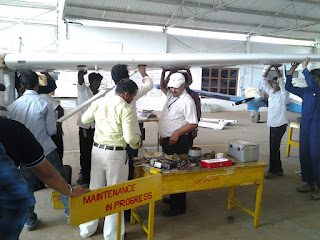On the Job Training (OJT) - Line Maintenance
Reference CAR D2E-E8
Please leave comments and share.
4.17 On The Job Practical Training
4.17.1 For completion of the course, six months On the Job Training (OJT) shall be mandatory. These six months OJT may be given in a continuous period or may be divided into two segments of three months each. For imparting practical training on aircraft maintenance to the trainees, facilities acceptable to DGCA and as specified in Appendix V must exist.
OJT is knowledge obtained while
participating in accomplishing the task under the direction of a qualified
person or watching another demonstrate a task or activity and then
accomplishing the same action under supervision until satisfactory results are
obtained.
It is an effective method of training for subject matter and tasks that are difficult to understand if described or for which demonstration of capability is essential to correct completion. Practical skills may also be taught using OJT.
To make this method of training most effective, the process for providing the information should be standardized by using, for a particular task, the approved data from the article’s maintenance manual, and the referenced tools and/or equipment.
The process should document that the employee demonstrated the ability to accomplish the skill or task properly on the requisite OJT record.
The same process can then be used to train other employees to the same task, activity, or skill. Even with a very capable instructor, the AMO should ensure any OJT is well structured by establishing that the same key elements are included each time.
It is an effective method of training for subject matter and tasks that are difficult to understand if described or for which demonstration of capability is essential to correct completion. Practical skills may also be taught using OJT.
To make this method of training most effective, the process for providing the information should be standardized by using, for a particular task, the approved data from the article’s maintenance manual, and the referenced tools and/or equipment.
The process should document that the employee demonstrated the ability to accomplish the skill or task properly on the requisite OJT record.
The same process can then be used to train other employees to the same task, activity, or skill. Even with a very capable instructor, the AMO should ensure any OJT is well structured by establishing that the same key elements are included each time.
APPLIED PRACTICAL LINE MAINTENANCE OPERATION:
AIRFRAME/ENGINE / AVIONICS
The required materials and publications include the following:
a) Extract from the approved maintenance programme
b) Appropriate aircraft, engine or part there of
c) Aircraft maintenance manual (AMM)
d) Operators’ minimum equipment list (MEL)
e) Operators maintenance control manual
f) AMO tasks or job cards
g) Operator’s technical log
h) Associated technical tools or test equipment
Operating conditions defined by the instructor should include not to be limited to the following:
a) Simulated aircraft departure time
b) Simulated aircraft maintenance state and age
c) Availability of spare parts
c) Availability of spare parts
d) Availability of role play flight crew for questioning
e) Statement if a defect is found, trainee must make decision to repair, replace or defer
f) Recording of work in accordance with AMO and operator manuals and with DGCA regulations
g) Simulated conditions of the maintenance facility
Exercises should be designed to give trainees practices in the following
a) Manual and diagnostic skills
b) Compilation of necessary additional work or job cards
c) Understanding of flight crew entries in the technical logs
d) Verbal briefing and de-briefing of flight crew
e) Correct use of manuals such as the AMM or MEL
f) Making of accurate and complete entries in the technical logs, work or job cards.Please leave comments and share.


Comments